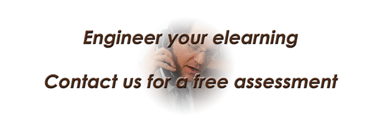In a previous post I talked a little bit about my experience during the lockdown and how we all went remote during 2020. On the personal level, that affected how I interacted with my coworkers, also I had to come up with solutions for converting classroom activities to eLearning, and fast.
Table of Contents
- 1. Lack of Social Interaction in eLearning
- 2. Reduced Engagement in the eLearning Setting
- 3. Increased Screen Time due to eLearning Activities
- 4. Lack of Access to Technology Means No Access to eLearning
- Takeaways
- References
Without a doubt, the COVID-19 pandemic dramatically changed the way we live and learn, and eLearning, even though it was already known as a tool for educational content delivery, it consolidated its popularity as an alternative to traditional in-person instruction. While eLearning has its advantages, such as flexibility and accessibility, it also has some negative effects that have been highlighted during the pandemic. In this blog post, I will explore some of the research on the negative effects of eLearning for education during the COVID-19 pandemic that has been published so far. So, below you will find some of the points where I found research on the negative impact of the lockdown on education through eLearning.

1. Lack of Social Interaction in eLearning
Here is an area where you will find a lot of research because the lockdown truly affected the mental health of students, even though eLearning was providing content and education it also isolated students due to the lack of social interaction, or person-in-person contact. Social interaction plays a crucial role in students’ development and their ability to learn, especially in very young students (k-12 grades). Research has shown that social interaction is essential for the acquisition of social skills and for building relationships with peers and instructors (Larson & Verma, 2019). During the pandemic, many students were forced to attend online classes, which limited their opportunities for social interaction (think play time, group projects). A study conducted by UNESCO (2020) found that the lack of social interaction was one of the biggest challenges faced by students during the pandemic.
2. Reduced Engagement in the eLearning Setting
Another negative effect of eLearning is reduced engagement, especially if the materials are not designed properly. eLearning can be less engaging than traditional in-person instruction, this is especially true in very young students. According to a study by Alemu and colleagues (2020), students who participated in eLearning were less engaged than those who received face-to-face instruction. Lack of engagement can lead to decreased motivation and reduced academic performance.
3. Increased Screen Time due to eLearning Activities
eLearning requires students to spend extended periods in front of a computer screen. Increased screen time has been linked to various health problems, including eye strain, headaches, and sleep disturbances (Rosenfield, 2016). The COVID-19 pandemic exacerbated the issue, with students spending more time than ever in front of screens due to the switch to online learning. This was also true during leisure time since there were no opportunities to go outside due to the lockdown. Many young students resorted to playing online games and watching multimedia (this includes streaming services.)
4. Lack of Access to Technology Means No Access to eLearning
Finally, eLearning has highlighted the issue of the digital divide, not only within a country but among countries that have a less developed internet network. Not all students have access to technology or high-speed internet, which can limit their ability to participate in eLearning. The digital divide has been a longstanding issue, but the pandemic has highlighted its impact on education. According to a study by UNESCO (2020), more than 90% of the world’s students were affected by school closures during the pandemic, with many lacking access to technology and the internet.
Takeaways
eLearning emerged as a popular alternative, but I would say the only realistic option due to the circumstances, to traditional in-person instruction during the COVID-19 pandemic. While I have highlighted its advantages in other posts, I showed that it can produce some negative effects, including the lack of social interaction, reduced engagement, increased screen time, and the digital divide. These issues highlight the importance of finding a balance between traditional in-person instruction and eLearning. Education systems need to prioritize social interaction, engagement, and access to technology to ensure that all students have equal opportunities to learn.
Nevertheless, many schools came back from lockdown with a more open mind on the use of eLearning as a way to complement classroom instruction, and they have decided to keep a component in eLearning format. I believe eLearning proved that it can achieve educational objectives when properly designed but that it definitely needs the classroom component so that students thrive in their education.
If you would like to receive notifications for new content or access to exclusive content, sign up to our mailing list by using the form in this page. As always, please leave a comment below. Like this post. Share this post with others. Thank you.
References
Alemu, M., Yimer, T., & Mekonnen, T. (2020). Students’ academic engagement and e-learning during COVID-19 pandemic: the case of higher education. Journal of Education and Practice, 11(22), 36-43.
Larson, E., & Verma, S. (2019). Social interaction and the classroom environment: A review of the literature. Journal of Education and Learning, 8(3), 129-141.
Rosenfield, S. (2016). Computer vision syndrome (a.k.a. digital eye strain). Optometry in Practice, 17(1), 1-10.
UNESCO. (2020). Education in the time of COVID-19. Accessed May 2, 2023, from https://en.unesco.org/covid19/educationresponse

